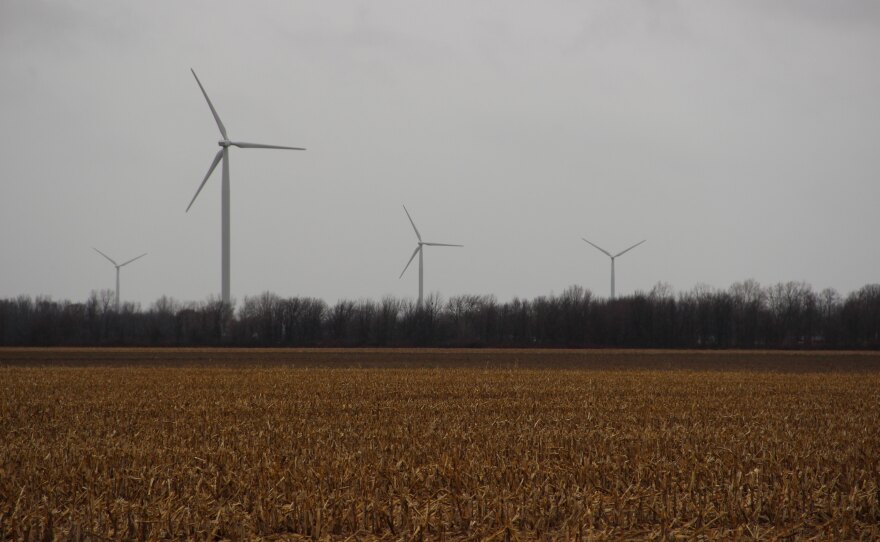The Gratiot County Wind Farm has 133 wind turbines scattered over more than 30,000 acres. It's the largest wind farm in Michigan. Each 1.6 megawatt wind turbine can generate enough power for 350 homes.
And this is what it sounds like when you stand directly beneath a wind turbine that stretches more than 450 feet into the sky with the wind blowing between 10 to 15 mph.
(Listen below - You can hear the turbine slow down - I think it's neat, but I'm a nerd.)
If you've driven along U.S. Route 127 north of Lansing, you've seen this wind farm. Here's a terrible photograph of how that looks:

Invenergy owns 69 of the turbines. DTE owns 64 of them. All the power that is produced here goes onto the grid for DTE Energy, which means the power generated in central Michigan goes to southeast Michigan.
The wind farm produces a total of 212.5 megawatts of renewable energy. Power companies in the state are required to generate 10% of their energy from renewable sources by 2015.
...the Gratiot County Wind Farm represents around 22% of the renewable power DTE generates today.
DTE Energy spokesman Scott Simons says the company is close to that goal, and the Gratiot County Wind Farm represents around 22% of the renewable power DTE generates today.
More of wind farms are going up around the state, so I wanted to know what it’s like for the people who live here.
The wind turbine I recorded above sits on the Humm family farm in Gratiot County.
I met up with Kent Humm outside his shop. It sits about a quarter mile from the wind turbine. This is what the turbine sounds like from there:
The wind farm started producing power for the grid last year.
In the radio story above, you can hear Kent Humm describe how he learned a lot about how the wind moves around his farm once the wind turbines started spinning. He says he'll use the turbines to get a sense for where they could be spraying their crops. They want to spray where wind speeds are low. The turbines, which can be seen for miles around, give them an indication of where they can spray.
The sound, he says, doesn't bother him. He calls it low background noise, and says he can't hear it inside his house.
A poll of the people in the local diner
It wasn't a proper poll, but I was introduced to a group of farmers and their spouses sitting around a big table having lunch in Anschutz Cafe. It's the main diner in town.
Most were supportive of the turbines. Marilyn Myers has been in this area her whole life.
She said the same thing Kent Humm did - that the sound is something you get used to. She said they have the windows open in the summer and it the sound doesn't bother them (even when the turbines engage their brakes to slow the blades down in high winds).
She said some were open-minded when the wind farm was being proposed, and others weren't.
"But, like we laugh now, that check coming in helps us out."
"When they were signing people up, the person was either just dead set against it. Didn't want nothing to do with it. Didn't want to ask questions. And then the next person was agreeable," said Myers. "But, like we laugh now, that check coming in helps us out."
There are around 250 families in this area that receive payments from the power companies that use their land. Nancy Shankle’s family is one of them. They get per acre payments, and royalty payments off the power that is produced.
And Kent Humm said the community went a long way in making sure everyone in the community got the same deal. Landowners get quarterly per-acre payments if the power company has a wind turbine on your land, or cables running underneath it.
According to Humm, payments can range from $70 to $75 per acre per year for land with cables underneath, to $300 per acre per year for land disturbed by a wind turbine.
And that seems to be a big reason for the support of this wind farm in Gratiot County. Many of the farmers in this area have a small stake in the commodity of wind.




















